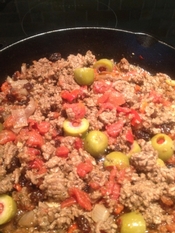|
|
 |

Aug 21, 2012
WINE WITH… PICADILLO
There are many good reasons why Picadillo is a favorite dish in Latin America, and why you should adopt it as one of your own favorite go-to recipes. It makes a meal that’s quick and easy to prepare and serve. The only ingredient in traditional Picadillo that might be thought of as even vaguely “exotic” is pimento-stuffed green olives (and capers may be easily substituted for the olives). Picadillo is simple to throw together at the last minute as a casual supper for two, and it’s also a terrific party dish that can be prepared a day or so ahead of time to serve a crowd (in fact it tastes even better when made a day ahead). Add rice and a green salad to the menu and presto--you’ve got a complete meal. ingredient in traditional Picadillo that might be thought of as even vaguely “exotic” is pimento-stuffed green olives (and capers may be easily substituted for the olives). Picadillo is simple to throw together at the last minute as a casual supper for two, and it’s also a terrific party dish that can be prepared a day or so ahead of time to serve a crowd (in fact it tastes even better when made a day ahead). Add rice and a green salad to the menu and presto--you’ve got a complete meal.
Our Mexican friend Carolemarie follows her family’s Picadillo recipe to make a delicious taco filling, while our pal Mary Ann, whose mother was Cuban, serves it as a favorite comfort food. Carolemarie’s version tends to be quite spicy, Mary Ann’s milder. Picadillo is a forgiving recipe, to be adjusted according to personal taste and imagination. We found that It adapts best to red wine, but if you drink only whites—well, you’ll come up with something that will be a felicitous accompaniment.
Picadillo
serves 4
1 medium onion, finely chopped
1 medium red, yellow or green bell pepper, minced
2 tablespoons olive oil
2-3 cloves garlic, minced
1 pound ground beef or bison
1 teaspoon each cumin and oregano (or more, to taste)
1 cup diced tomatoes, fresh or canned
1/2 cup red or white wine
1/4cup raisins
1/3 cup pimento-stuffed green olives cut in half or smaller if olives are very large (or substitute 2 tbs capers for the olives)
Salt and pepper
Sour cream or slivered almonds or pine nuts for garnish (optional)
Cook the onion and bell pepper in oil over medium heat until they soften (do not let the onions brown). Add the garlic and cook another couple of minutes, then add the beef. Add the meat, stirring occasionally, and continue cooking until it is cooked through. Add the raisins and olives, taste for seasoning, and simmer until most of the liquid is absorbed. Serve over brown or white rice.
* * *
This is quite clearly a red wine dish. The meatiness of the beef, coupled with the piquancy of the garlic, onions, cumin and olives, proves too forceful for most whites. Yet our tasting showed us that not all reds work equally well. We tried two Pinot Noirs, both of which were overwhelmed, and while the different flavors in the dish held up to tannins quite well, our picadillo did not much like wines that were notably taught or astringent The raisins make it somewhat sweet, but overly candied flavors were another no-no. The best wines, regardless of grape variety turned out to be ones with well-defined red and black fruit flavors, suppleness on the palate, and a firm finish. Perhaps not surprisingly, all hailed from New World vineyards.
Selection
|
Approx. Price
|
Comments
|
Beckman Vineyards, Santa Ynez Valley (California) “Cuvee Le Bec” 2010
|
$18
|
A Rhône-styled blend of Syrah, Grenache, Mourvedre and Counoise, this youthful fruit-forward wine meshed seamlessly with the picadillo. Unlike its French model, any peppery and herbal notes, while present, were relegated to the background, allowing the wine to taste deliciously refreshing. We served it slightly chilled, and would recommend that you do so too.
|
Frei Brothers (Dry Creek Valley (California) Zinfandel “Reserve” 2010.
|
$20
|
Not noticeably hot or heavy, this wine fairly bursts with ripe berry fruit flavors. Direct but in no sense intense, it feels smooth and sumptuous, and proved very comforting alongside this dish.
|
J. Lohr, Paso Robles (California) Cabernet Sauvignon “Seven Oaks” 2010
|
$17
|
This wine seemed too soft and lush when we took a sip before dinner, but almost magically firmed up when paired with the picadillo. We were surprised but delighted. So while we wouldn’t recommend most Cabernets with this particular dish (they’re just too forceful), we’re more than happy to recommend this one.
|
Ñandú, Mendoza (Argentina) Malbec 2010
(Imported by Polaris Wines)
|
$17
|
With hints of black licorice and flowers (perhaps violets) in the bouquet, this enticing wine is marked by vivid plum and dark berry fruit flavors. It provided an appealing contrast to the spicy elements in the picadillo, while having just the right combination of a supple texture followed by firm tannins.
|
Clayhouse Estate, Paso Robles (California) Petite Sirah “Old Vines Red Cedar Vineyard” 2009
|
$25
|
Most Petite Sirahs used to be mouth puckering because tight and astringent in their youth. These days, though, modern tannin-management techniques make more and more wines produced from this grape variety much softer and so easier to drink. This particular example is a case in point. Full of fruity flavors with echoes of supporting savory spice, it was a great partner for our picadillo. It not only tasted good at first sip, but also became gradually smoother and even more compelling in the finish.
|
|
 |
|